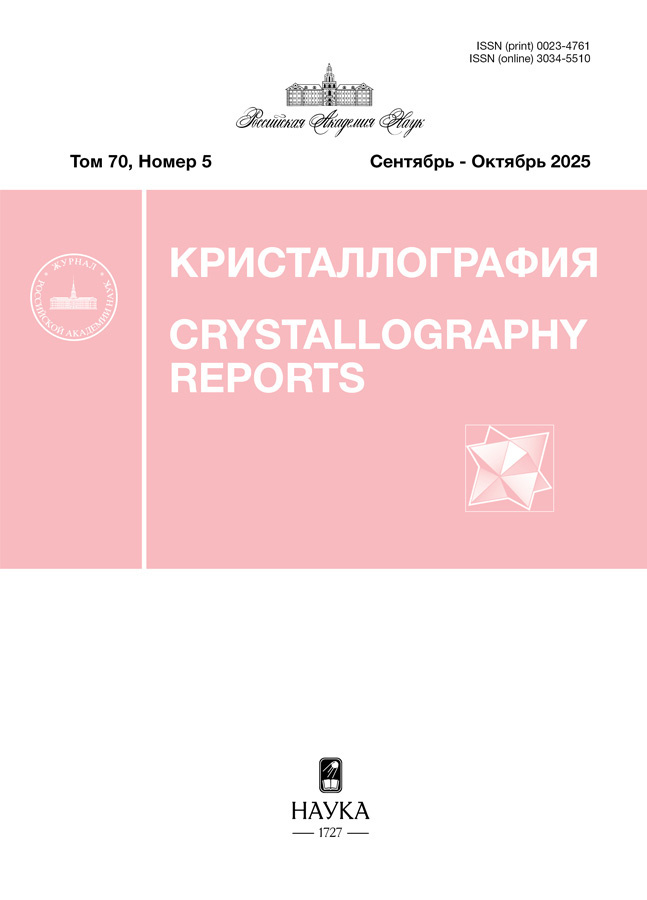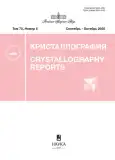Partially Disordered Crystalline State in a Thin Ge2Sb2Te5 Film: Manifestation of Thermally Induced Nanoscale Effect
- Authors: Mironov B.N.1, Poydashev D.G.1, Aseyev S.A.1, Malinovsky A.L.1, Avilov A.S.2, Ischenko A.A.3, Ryabov E.A.1
-
Affiliations:
- Institute of Spectroscopy of the Russian Academy of Sciences, Moscow, Troitsk, Russia
- Shubnikov Institute of Crystallography of the Kurchatov Complex Crystallography and Photonics of the NRC “Kurchatov Institute”, Moscow, 119333 Russia
- RTU–MIREA – Russian Technological University, Lomonosov Institute of Fine Chemical Technologies, Moscow, Russia
- Issue: Vol 70, No 5 (2025)
- Pages: 810-816
- Section: ПОВЕРХНОСТЬ, ТОНКИЕ ПЛЕНКИ
- URL: https://modernonco.orscience.ru/0023-4761/article/view/693864
- DOI: https://doi.org/10.31857/S0023476125050113
- EDN: https://elibrary.ru/vfywzl
- ID: 693864
Cite item
Abstract
About the authors
B. N. Mironov
Institute of Spectroscopy of the Russian Academy of Sciences, Moscow, Troitsk, RussiaMoscow, Troitsk, Russia
D. G. Poydashev
Institute of Spectroscopy of the Russian Academy of Sciences, Moscow, Troitsk, RussiaMoscow, Troitsk, Russia
S. A. Aseyev
Institute of Spectroscopy of the Russian Academy of Sciences, Moscow, Troitsk, RussiaMoscow, Troitsk, Russia
A. L. Malinovsky
Institute of Spectroscopy of the Russian Academy of Sciences, Moscow, Troitsk, RussiaMoscow, Troitsk, Russia
A. S. Avilov
Shubnikov Institute of Crystallography of the Kurchatov Complex Crystallography and Photonics of the NRC “Kurchatov Institute”, Moscow, 119333 Russia
Email: avilovanatoly@mail.ru
Moscow, 119333 Russia
A. A. Ischenko
RTU–MIREA – Russian Technological University, Lomonosov Institute of Fine Chemical Technologies, Moscow, RussiaMoscow, Russia
E. A. Ryabov
Institute of Spectroscopy of the Russian Academy of Sciences, Moscow, Troitsk, RussiaMoscow, Troitsk, Russia
References
- Талочкин А.Б., Кох К.А., Терещенко О.Е. // Письма в ЖЭТФ. 2021. Т. 113. Вып. 10. С. 683. https://doi.org/10.31857/S1234567821100086
- Козюхин С.А., Лазаренко П.И., Попов А.И., Еременко И.Л. // Успехи химии. 2022. Т. 91. Вып. 9. RCR5033. https://doi.org/10.1070/RCR5033
- Prabhathan P., Sreekanth K.V., Teng J. et al. // iScience. 2023. V. 26. № 12. P. 107946. https://doi.org/10.1016/j.isci.2023.107946
- Wuttig M., Bhaskaran H., Taubner T. // Nature Photon. 2017. V. 11. P. 465. https://doi.org/10.1038/nphoton.2017.126
- Kooi B.J., Wuttig M. // Adv. Mater. 2020. V. 32. № 21. Р. 1908302. https://doi.org/10.1002/adma.201908302
- Lee Y.K., Yoo C., Kim W. et al. // J. Mater. Chem. C. 2021. V. 9. P. 3708. https://doi.org/10.1039/D1TC00186H
- Neumann C.M., Okabe K.L., Yalon E. et al. // Appl. Phys. Lett. 2019. V. 114. Р. 082103. https://doi.org/10.1063/1.5080959
- Wang X.P., Li X.B., Chen N.K. et al. // Adv. Sci. 2021. V. 8. Р. 2004185. https://doi.org/10.1002/advs.202004185
- Simpson R.E., Fons P., Kolobov A.V. et al. // Nat. Nanotechnol. 2011. V. 6. P. 501. https://doi.org/10.1038/nnano.2011.96
- Urban P., Schneider M.N., Erra L. et al. // Cryst. Eng. Comm. 2013. V. 15. P. 4823. https://doi.org/10.1039/C3CE26956F
- Lotnyk A., Dankwort T., Behrens M. et al. // Acta Mater. 2024. V. 266. P. 119670. https://doi.org/10.1016/j.actamat.2024.119670
- Zheng Y., Cheng Y., Huang R. et al. // Sci. Rep. 2017. V. 7. P. 5915. https://doi.org/10.1038/s41598-017-06426-2
- Wang Y., Chen X., Cheng Y. et al. // IEEE Electron Device Lett. 2014. V. 35. № 5. P. 536. https://doi.org/10.1109/LED.2014.2308909
- Njoroge W.K., Wöltgens H.-W., Wuttig M. // J. Vac. Sci. Technol. A. 2002. V. 20. P. 230. https://doi.org/10.1116/1.1430249
- Do K., Lee D., Ko D.-H. et al. // Electrochem. Solid-State Lett. 2010. V. 13. P. H284. https://doi.org/10.1149/1.3439647
- Миронов Б.Н., Компанец В.О., Асеев С.А. и др. // ЖЭТФ. 2017. Т. 151. С. 494. https://doi.org/10.7868/S0044451017030051
- Aseyev S.A., Ryabov E.A., Mironov B.N. et al. // Chem. Phys. Lett. 2022. V. 797. P. 139599. https://doi.org/10.1016/j.cplett.2022.139599
- Filippetto D., Musumeci P., Li R.K. et al. // Rev. Mod. Phys. 2022. V. 94. P. 045004. https://doi.org/10.1103/RevModPhys.94.045004
- Alwi H.A., Kim Y.Y., Awang R. et al. // Int. J. Heat Mass Transfer. 2013. V. 63. P. 199. https://doi.org/10.1016/j.ijheatmasstransfer.2013.03.062
- Lankhorst M.H.R., Ketelaars B.W.S. M.M., Wolters R.A.M. // Nat. Mater. 2005. V. 4. P. 347. https://doi.org/10.1038/nmat1350
- Hegedüs J., Elliott S.R. // Nat. Mater. 2008. V. 7. P. 399. https://doi.org/10.1038/nmat2157
- Siegrist T., Jost P., Volker H. et al. // Nat. Mater. 2011. V. 10. P. 202. https://doi.org/10.1038/nmat2934
- Momand J., Wang R., Boschker J.E. et al. // Nanoscale. 2015. V. 7. P. 19136. https://doi.org/10.1039/C5NR04530D
- Santala M.K., Reed B.W., Topuria T. et al. // J. Appl. Phys. 2012. V. 111. Р. 024309. https://doi.org/10.1063/1.3678447
- Liu C., Tang Q., Zheng Y. et al. // APL Mater. 2022. V. 10. № 2. Р. 021102. https://doi.org/10.1063/5.0079370
- Phillips J.C. // J. Non-Cryst. Solids. 1979. V. 34. P. 153. https://doi.org/10.1016/0022-3093(79)90033-4
- Phillips J.C. // Phys. Status Solidi. B. 1980. V. 101. № 2. P. 473. https://doi.org/10.1002/pssb.2221010204
- Popov A.I. // Semiconductors and Semimetals. V. 78. / Ed. Fairman R., Ushkov B. Amsterdam, 2004. P. 51.
- Guo P., Sarangan A.M., Agha I. // Appl. Sci. 2019. V. 9. № 3. P. 530. https://doi.org/10.3390/app9030530
- Zhang W., Wuttig M., Mazzarello R. // Sci. Rep. 2015. V. 5. Р. 13496. https://doi.org/10.1038/srep13496
Supplementary files








